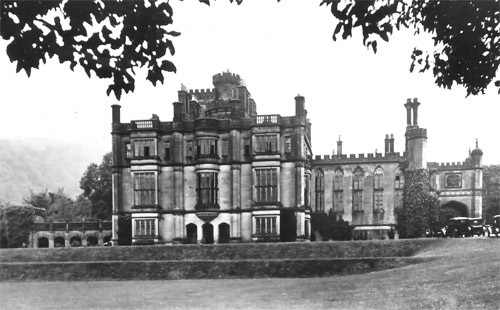Ilam Hall
Staffordshire
| Location | Ilam | ||
| Year demolished | c.1935 | ||
| Reason | Insufficient wealth | ||
| See all images: | Gallery | ||
| << Back to the main list |
It was easily acknowledged that Ilam Hall enjoyed a most beautiful situation; in a vale, surrounded by luxuriant planting, and a strong river fed by two subterranean streams; the Manifold and the Hamps. The house which sat in the centre was a fine example of the northern Gothic Revival tradition and now both the grounds and remains of the hall are enjoyed as a youth hostel.
 The original Ilam Hall was a large Elizabethan mansion built by the Port family who bought the estate (formerly part of the lands of Burton-on-Trent Abbey) from William Paget in 1547. The estate was then sold to David Pike Watts, a wealthy wine merchant, in 1809. His two sons were killed in the Napoleonic wars and so the house was inherited by his daughter Mary on his death in 1816. She married Jesse Russell (b.1786 – d.1875), who had made a fortune in soap manufacturing, and the couple created a new family name of Watts-Russell. The family, which grew to include eight children, lived in the original house until 1820 when it was pulled down to create the site for the new house.
The original Ilam Hall was a large Elizabethan mansion built by the Port family who bought the estate (formerly part of the lands of Burton-on-Trent Abbey) from William Paget in 1547. The estate was then sold to David Pike Watts, a wealthy wine merchant, in 1809. His two sons were killed in the Napoleonic wars and so the house was inherited by his daughter Mary on his death in 1816. She married Jesse Russell (b.1786 – d.1875), who had made a fortune in soap manufacturing, and the couple created a new family name of Watts-Russell. The family, which grew to include eight children, lived in the original house until 1820 when it was pulled down to create the site for the new house.
The new house was firmly part of the Gothic Revival movement which was particularly influential in northern England, reflecting the stronger Catholic tastes of the gentry, and especially that of the Earl of Shrewsbury. Starting in 1811, the Earl's grand building plans expanded his Staffordshire seat, Alton Lodge, into Alton Abbey, latterly under the guidance of A.W.N. Pugin, the most fervent advocate of the belief that religion should be reflected in architecture; that only the Gothic was the one true style for Britain, a homage to a pre-Reformation age. The Earl's influence ensured that a wave of similar buildings - build with varying degrees of authenticity - sprang up throughout the Victorian era.
Ilam Hall was built between 1821-26 for Jesse Watts-Russell to a design was by John Shaw (b.1776 - d.1832) who had made extensive Gothic alterations to Blendon Hall in Kent c.1815 (dem. 1934) and Christ's Hospital in London in 1816. It's not known how Watts Russell came to choose Shaw as his architect but certainly the design of Ilam is bold and confident, though if there were to be criticism it was perhaps lacking some of the picturesque qualities which created a more pleasing outline - but it was nonetheless a fine seat for a local gentleman. The house was actually built by the mason James Trubshaw (b.1777 - d.1853) who had also worked at Ashcombe Park and built Wolseley Hall, both in Staffordshire.
A measure of the perceived beauty of the house was that it was featured in Volume I of the Rev. F.A.O Morris' series 'County Seats of the Noblemen and Gentlemen of Great Britain and Ireland'. This important series reflected those houses thought to be the best examples of our country houses.
On the death of Jesse Watts-Russell, the house and 998 acres were put up for auction in 1875 but failed to sell despite bidding going to £73,000 from a starting offer of £50,000. It was later sold to the Rt. Hon. Robert W. Hanbury MP who remained there until his death in 1903. His will was disputed by his nieces who won a ruling that Mrs Hanbury only had a life interest in the Hall but who remained living there with her new husband (she having married again a year after the death of her first husband).
In July 1910, Ilam Hall and the now reduced 852-acre estate was auctioned again but this time reached only £38,500 towards a reserve of £54,000, and was later sold privately. The house then opened as a hotel/restaurant in 1927 but by the 1930s was again empty and was sold for demolition. By 1935, almost all the main central section of the house had been pulled down, leaving just the formal entrance, service wings and estate buildings. It was these remains which were bought by Sir Robert McDougall (of flour fame) to save them from the same fate. He donated the remains to the National Trust with the stipulation that it remain a youth hostel, which it is today, run by the YHA.